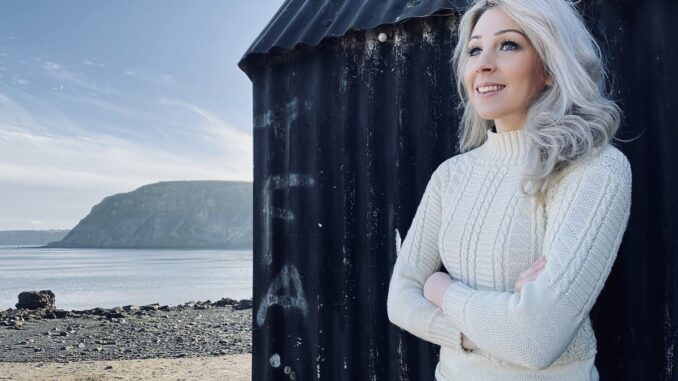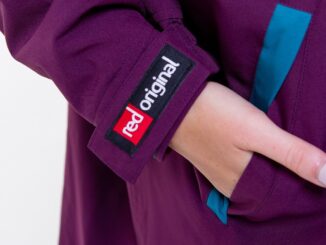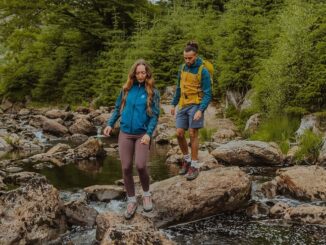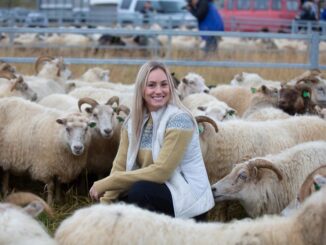
Winter is approaching, the wind is getting up, the rain coming in and English coastal clothing is having its moment again.
The smocks, deckhand jackets and chunky woolly beanies are coming out, and we are wrapping up in heritage patterns and getting out and into our go-to seamless, close-knit Gansies.
Wakefield-born Matthew Pugh founded Berties of Bay in Robin Hood Bay in northeast England, famous for being the home of Captain Cook (now a museum) who, before joining the Navy was apprenticed to a draper in the small fishing harbour of Staithes, 11 miles north of Whitby on the North Yorks Moors coast.
Son of an electrician, Pugh, who supplies traditional English coastal clothing worldwide, reviving old patterns and based in the Old Bakery on Chapel Street, says:
“A Gansey is a traditional wool jumper worn by fisherman, knitted in an intricate pattern without seams to keep the heat in and water out.”
“There’s a different pattern for each fishing port as this detailed needlework was certainly not a fashion statement but a very clever way of identifying where washed-up sailor’s bodies should be returned to after going overboard, so their loved ones could say goodbye and have closure.
“Our Whitby pattern is moss stitch, resembling waves, with cables and ridges referencing waves, ladders and steps (as in 199 steps up to Whitby Abbey) and St Andrews flags to commemorate the Scottish settlers who moved down to Whitby to fish for silver darlings – herrings.
“The Staithes Pattern consists of two motifs: moss stitch covering the top half of the Gansey with bands of rigging running horizontally through it with the lower half plain. This Gansey design was worn by the Victorian Iconic Hero Henry Freeman who was famous for being the sole survivor of the historic lifeboat disaster at sea which took place in 1861 just outside Whitby.”
The Flamborough pattern has a ‘fence’ or ‘flag’ pattern, symbolising protection. Scarborough sweaters are recognisable by the ‘marriage lines’ or wavy lines that often represent the unpredictability of life and the sea. Robin Hood’s Bay jumpers use sequences of ‘tree’ and ‘fern’ motifs while the Humber Keel, recalling after the keelboats that once dominated the River Humber, employs upward pointing anchors. Some use motifs like lightning strikes, hail and rain.

Gansey or ‘guernsey’ sweaters are knitted with 5 ply heavy-duty worsted wool in one piece with no seams. The intricate patterns often concentrate towards the upper part of the garment around the shoulders, arms and chest and are often made reversible so they can be worn either way around prolonging the wear of the Gansey before it needs repair. As the bottom half of the Gansey suffered most wear and tear it was often left plain so the lower body, cuffs and the plain of the sleeves could easily be pulled out and re-knitted. Fisherman would wear a Gansey next to the skin with the addition of a pure silk scarf. To show he was out of work, a fisherman would turn up the bottom of his Gansey to let captains know he was available for hire. The turned-up section also doubled as a handy pocket later adopted to keep their tobacco and matches.
Pugh, who wanted to become a fashion designer and studied at Wakefield’s College of Art & Design, continues:
“Each £130 Gansey is made to measure and takes six to eight weeks to hand knit and you can pick and choose your own specifications.
“I wanted to bring these traditional jumpers back to life. They had to be 100% British made from 100% British oiled wool and in the traditional patterns and construction. The sweaters were knitted on five circular needles which means they were knitted like socks.
“All our garments are knitted and manufactured by family run businesses throughout the UK. It is very important to us we keep our British heritage alive, and we can only do this by using British wool and by having our products British made. We do not disclose who and where because it has taken us several years to master the garments, we have in our trans-seasonal range by working closely with our makers and in particular our Gansey Jumpers it is very bespoke and niche what we have created and therefore we keep this very close to our chest, pardon the pun. We manufacture and knit in small batches by colour and design which keeps the demand very high, allowing our customers to purchase off the peg but still have something very special which is not mass produced.”
Fishing folk around the UK made gansies with the wool they sheared from their own sheep, with Pugh adding:
“Leaving the lanolin in the wool – that’s the oil from the sheep’s skin – meant they kept them warm, and dry. We sell a hundred gansies a week through our stores in Robin Hood’s Bay and Sandsend, our website and stockists worldwide. We recently launched the Explorer Smock, which is also proving very popular. The leather anchor belts are made by a former professional magician in his garden shed!”
Yorkshire’s long knitting tradition is remembered by the Gansey Girl sculpture standing on the North Pier harbour at the seaside town of Bridlington. Mothers, wives and daughters knitted their love, hope and prayers into every stitch, crafting patterns unique to their families or communities. Knitting was interwoven with Yorkshire’s cultural identity, and a gansey is part of its cultural identity and a symbol of its maritime heritage. Every thread, every stitch and every motif has a meaning.
The labels of Berties of Bay’s Gansey range say it all: “100% British Wool, bloody warm.”
But why Bertie’s?
“When undecided on using personal family names, famous local family names and iconic historical names, one Friday evening after too many glasses of vino my cat walked into the living room and that was it, Berties Of Bay.”
For more information on Gansey warm British wool sweaters from Berties of Bay, please visit: www.bertiesofbay.co.uk.
Author Bio:
Kevin Pilley is a former professional cricketer and chief staff writer of PUNCH magazine. His humour, travel, food and drink work appear worldwide, and he has been published in over 800 titles.
Photographs courtesy of Berties of Bay





Be the first to comment